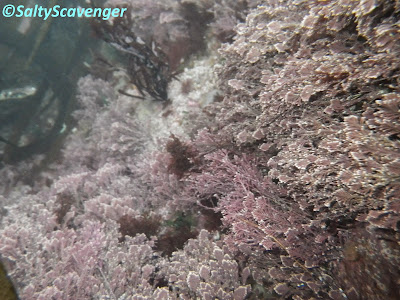The shore comprises shelving bedrock with gullies and rockpools. Lichens communities dominate large areas of the shore, eventually giving way to barnacle and mussel/fucoid communities. Rockpools occur throughout the shore, varying in species composition depending on their level of exposure to air and wave.
Below are images of the habitats and organisms you may encounter whilst rockpooling on this shore:
 |
The shore comprises shelving bedrock with gullies and rockpools. Lichens communities dominate large areas of the shore before they give way to barnacle and mussel/fucoid communities. Rockpools occur throughout the shore, varying in species composition depending on their level of exposure to air and wave. Habitat classification: LR.FLR.Lic.YG (Yellow and grey lichens on supralittoral rock) EUNIS B3.111, LR.FLR.Lic.Ver (Verrucaria Maura on littoral fringe rock) EUNIS: B3.113, LR.FLR.Rkp.Cor (Coralline crust dominated shallow eulittoral rockpools) EUNIS: A1.4111, LR.HLR. MusB (Mussel and/or barnacle communities) EUNIS: A1.11.
|
Coralline rockpools and lower barnacle/fucoid shore communities:
 |
| On the mid to lower shore the coralline rockpools increase in species diversity, including increased numbers of red seaweeds and gastropods. Habitat classification: LR.FLR.Rkp.Cor.Cor (Coralline crusts and Corallina officinalis in shallow eulittoral rockpools) EUNIS: A1.4111. |
 |
| The coralline rockpools come in a variety of shapes, sizes and depths which in turn influences the species found within. |
 |
| A large coralline rockpool. |
 |
| Corallina officinalis forms a turf on the edge of this deeper coralline rockpool. |
 |
| The coralline rockpools support a variety of species, including Corallinaceae crusts, Mytilus edulis, Corallina officinalis, Ulva spp and China limpets (Patella ulyssiponensis). The grazing gastropods can reduce the abundance of seaweeds within the rockpool, sometimes to such an extent that only a few non encrusting individuals remain! |
 |
| Periwinkles (Littorina spp) |
 |
| A blenny and beadlet anemones (Actina equina) |
 |
| Corallinaceae crusts and Corallina officinalis. |
 |
| Corallina officinalis. |
 |
| Corallina spp. turf |
 |
| Barnacles 'peak' out from the surrounding Corallinaceae crusts that envelope them. |
 |
| A china limpet (Patella ulyssiponensis) |
 |
| Corallinaceae crusts and sponge. |
 |
| Snakelocks anemones (Anemonia viridis) |
 |
Where seaweeds can avoid grazing pressure a range of filamentous reds occur.
Ceranium spp |
 |
| Many seaweeds avoid grazing by living on the grazers' shell! |
 |
| A limpet encrusted by Corallinaceae crust. |
 |
| Coralline rockpools of the lower shore support a greater number of brown seaweeds, and on this shore are typically characterised by the presence of the brown forking weed (Bifurcaria bifurcata). Habitat classification: LR.FLR.Rkp.Cor.Bif (Bifurcaria bifurcata in shallow eulittoral rockpools) EUNIS: A1.41113 |
 |
| Bifurcaria bifurcata and Corallina officinalis |
 |
| Young Himanthalia elongata overgrows Bifurcaria bifurcata and could, at this stage of growth, be confused with it. |
 |
| Kelps may also be present within the deeper lower shore rockpools. |
 |
| Red seaweed diversity and abundance increase within these deeper lower shore rockpools. |
 |
| Chondrus crispus |
 |
| Robust fucoids occur within a discrete band across the bedrock, marking the boundary between the barnacle dominated communities to the barnacle and fucoid communities. |
 |
| Robust Fucus spp. showing signs of winter die back. |
 |
| New growth of Fucus spp. |
 |
| Deep crevices run through the bedrock, these shady areas retain water and contain coralline rockpools. |
 |
| As the lower shore is reached there is an increase in those species that are more vulnerable to dessication. Beadlet anemones occur at a high abundance and Coralline algae is also able to grow where water seeps down the rock from the rockpools above. Habitat classification: LR.HLR.MusB (Mussel and/or barnacle communities) EUNIS A1.11. |
 |
Dog whelk (Nucella lapilus) abundance increase.

Dog whelks (Nucella lapilus), Limpets and barnacles.
|
 |
| Eventually the low water mark is characterised by Corallinaceae crusts and red seaweeds that cover the lower shore bedrock |












































No comments:
Post a Comment